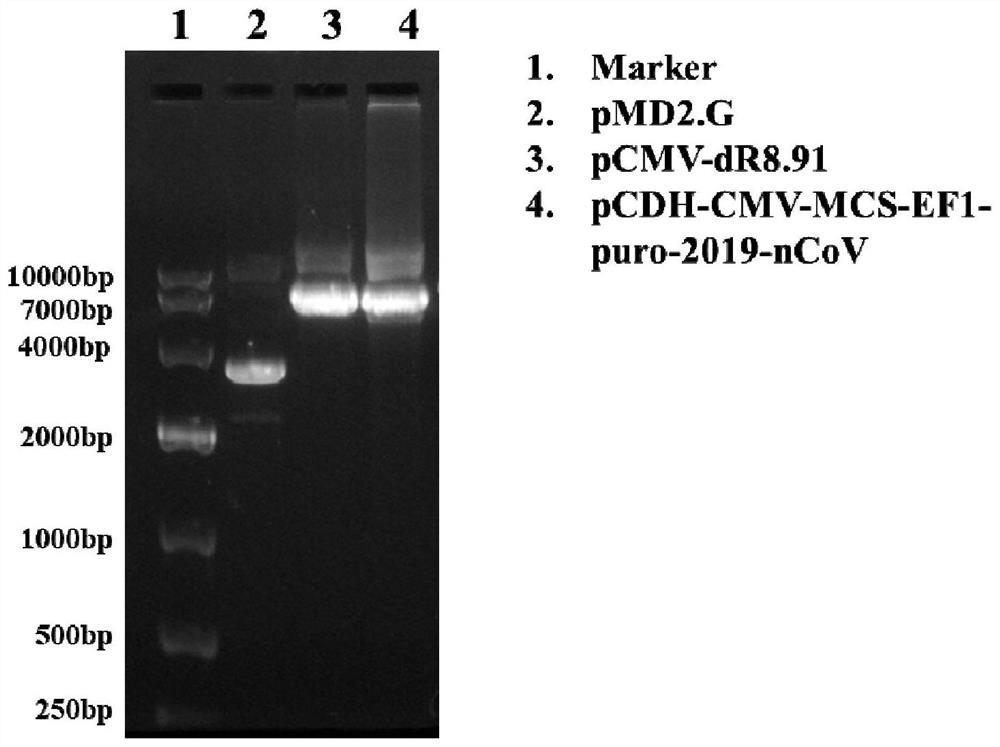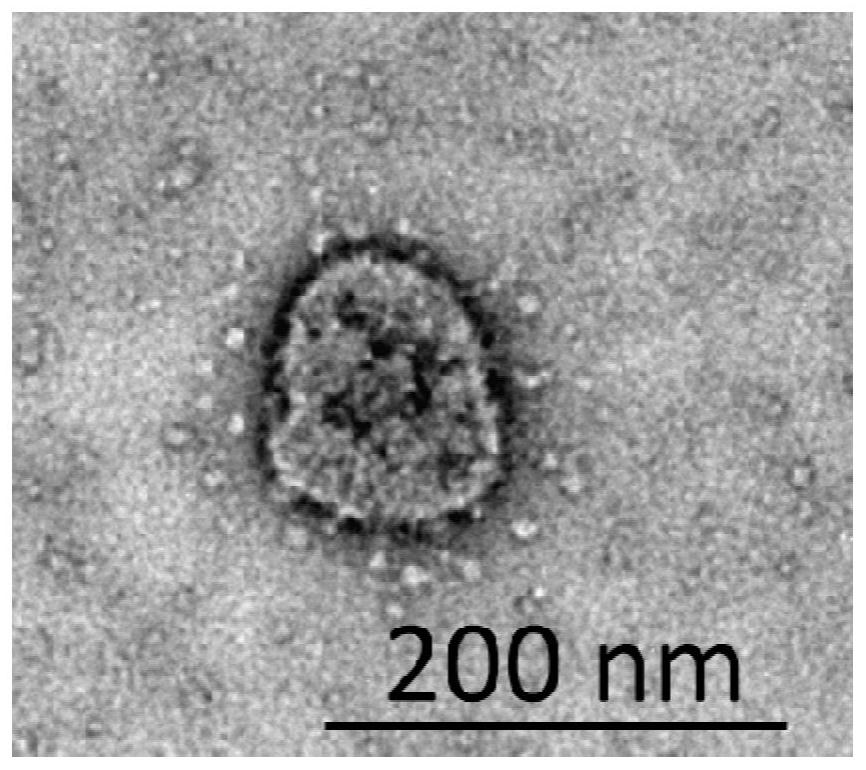Novel coronavirus nucleic acid pseudovirus standard substance for detection and preparation method thereof
A coronavirus and standard substance technology, applied in the field of genetic engineering, can solve problems such as poor stability, detection error, and inability to replace the virus detection process, and achieve good stability and safety.
- Summary
- Abstract
- Description
- Claims
- Application Information
AI Technical Summary
Problems solved by technology
Method used
Image
Examples
Embodiment 1
[0085] Embodiment 1 novel coronavirus pseudovirus preparation scheme one
[0086] In this example, the lentiviral particle packaging gene sequence 1 (ORF1ab-1 gene), gene sequence 2 (E gene) and gene sequence 3 (N gene) fragment RNA was prepared by the following method:
[0087] 1.1 Cloning gene sequence 1 (ORF1ab-1 gene), gene sequence 2 (E gene) and gene sequence 3 (N gene) fragments by PCR from 2019-nCoV (or SARS-CoV-2) genome cDNA ( figure 1 ) and linearize the pCDH-CMV-MCS-EF1-puro vector plasmid, the primers are as follows (Table 1):
[0088] Table 1 Primer sequences of gene sequence 1, gene sequence 2 and gene sequence 3
[0089]
[0090] 1.2 Through the design of primers, each fragment of gene sequence 1, gene sequence 2 and gene sequence 3 of 2019-nCoV (or SARS-CoV-2) and the linearized vector plasmid have 20bp repeat sequences at both ends in order for subsequent Homologous recombination join;
[0091] 1.3 Perform agarose gel recovery and purification of the cl...
Embodiment 2
[0106] Embodiment 2 novel coronavirus pseudovirus preparation scheme two
[0107] In this embodiment, the lentiviral particle packaging gene sequence 1 (ORF1ab-1 gene) and gene sequence 3 (N gene) fragment RNA was prepared by the following method:
[0108] 2.1 Clone gene sequence 1 (ORF1ab-1 gene) and gene sequence 2 (N gene) fragments by PCR from 2019-nCoV (or SARS-CoV-2) genome cDNA and linearize the pLVX vector plasmid. See Table 1 for primers :
[0109] 2.2 Through the design of primers, each fragment of gene sequence 1 and gene sequence 3 of 2019-nCoV (or SARS-CoV-2) and the linearized vector plasmid have a 20bp repeat sequence at both ends in order for subsequent homologous recombination connection ;
[0110] 2.3 Perform agarose gel recovery and purification of the cloned gene fragments and linearized vector plasmids;
[0111] 2.4 Connect the gene sequence 1 and gene sequence 3 fragments of 2019-nCoV (or SARS-CoV-2) into one fragment by fusion PCR method;
[0112] 2....
Embodiment 3
[0123] Embodiment 3 novel coronavirus pseudovirus preparation scheme three
[0124] In this embodiment, the fragment RNA of lentiviral particle packaging gene sequence 3 (N gene) is prepared by the following method:
[0125] 3.1 From the 2019-nCoV (or SARS-CoV-2) genome cDNA, clone the gene sequence 3 (N gene) fragment by PCR and linearize the pBoBi vector plasmid. The primer sequences are shown in Table 1:
[0126] 3.2 Through the design of primers, each fragment of gene sequence 1, gene sequence 2 and gene sequence 3 of 2019-nCoV (or SARS-CoV-2) and the linearized vector plasmid have 20bp repeat sequences at both ends in order for subsequent Homologous recombination join;
[0127] 3.3 Perform agarose gel recovery and purification of the cloned gene fragments and linearized vector plasmids;
[0128] 3.4 Connect each fragment of the gene sequence 3 of 2019-nCoV (or SARS-CoV-2) into one fragment by fusion PCR method;
[0129] 3.5 Take the PCR tube, add the 2019-nCoV (or SARS...
PUM
 Login to View More
Login to View More Abstract
Description
Claims
Application Information
 Login to View More
Login to View More - R&D
- Intellectual Property
- Life Sciences
- Materials
- Tech Scout
- Unparalleled Data Quality
- Higher Quality Content
- 60% Fewer Hallucinations
Browse by: Latest US Patents, China's latest patents, Technical Efficacy Thesaurus, Application Domain, Technology Topic, Popular Technical Reports.
© 2025 PatSnap. All rights reserved.Legal|Privacy policy|Modern Slavery Act Transparency Statement|Sitemap|About US| Contact US: help@patsnap.com



